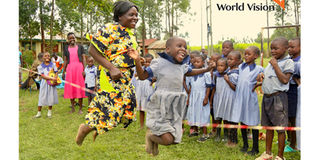How learning through play improves the performance of children in school
Sponsored by World Vision Kenya

By Ellenah Wangui, Let’s Play and Learn Project Manager, World Vision Kenya
Play is considered a normal activity that children frequently do as they grow up. Aside from being a fun activity that occupies children and makes them happy, play also contributes to the optimal development of boys and girls in many ways.
It is a known fact that continuous play goes a long way in improving the mental, physical, social, and emotional well-being of children and young people. This is achieved through active engagement in play that is experienced as joyful, meaningful, socially interactive, actively engaging, and iterative.
The benefits of play in learning can also be harnessed in the education sector, to help improve learning outcomes and enhance the performance of children in school.
Through its Let's Play and Learn project, which is funded by the LEGO Foundation, World Vision Kenya has been building the capacity of teachers and parents to effectively incorporate the Learning Through Play approach using an effective pedagogy or method of teaching that improves the learning capabilities of children.
This approach stretches the thinking capabilities of pupils to higher levels through the integration of fun activities and games in the classroom environment.
The project specifically seeks to improve literacy among early grade learners (pupils in Grade One, Two, and Three). It is currently being implemented in parts of Narok and Kakamega counties that experience low literacy levels among children. Currently, 40 schools from both areas are benefitting from this initiative, which is expected to trickle down to learners in other counties too.
The Let’sPlay and Learnproject is in line with the Competence-Based Curriculum (CBC) that is being implemented in Kenya. It is designed to emphasise the significance of developing skills, core competencies, and knowledge, as well as their application to real-life situations.
As such, the play-based approach complements the CBC by making learning practical, real, and meaningful, instead of just being theoretical.
Under the Learning Through Play approach, teachers are encouraged to plan for lessons that incorporate both child-initiated and teacher-supported learning. They deliberately encourage children’s learning and inquiry through games. This is a significant innovative strategy that promotes pupil’s engagement, inclusion, holistic skills development, and lifelong learning.
Teachers do this by carefully assembling various types of play materials that schools, children as well as their parents are empowered to develop through low-cost and locally available resources, which are easily accessible to them. These include bottles, beads, seeds, soil, sticks, rags, sacks, papers, and recycled plastic materials that come in handy while developing play items.
Through this innovative teaching approach, children get the opportunity to explore, experiment, discover and solve problems in imaginative and playful ways. It also promotes positive attitudes towards learning, which include curiosity, enthusiasm, and persistence. This thereby replaces the traditional rote learning model, which puts a lot of emphasis on memorisation.
An example of a common play-based activity that can be adapted for learning purposes is the ball game. Here, the teacher or children throw a ball from one person to another. Whoever catches the ball is required to say a new vocabulary or word that they learned during that particular lesson. This helps with grammar, pronunciation, vocabulary building and language development skills. It also builds children's concentration and communication skills.
Similarly, children can easily grasp the concept of volume, capacity, and fractions in mathematics by playing the measurement game with recycled plastic bottles that they will keep emptying and filling with water or soil at different levels or volumes. Coloured sticks can also be used to learn other arithmetic concepts like classification, addition, subtraction, multiplication, and division.
Other play materials that children can make and use for learning include alphabet and number charts made from seeds of different colours as well as items moulded using clay.
These play-based activities have gone a long way in enabling teachers to transform classroom experiences into inclusive, engaging, encouraging, and joyous sessions that stimulate optimal learning and improved education performance, among pupils.
They have also increased the participation of children in the learning process, thereby building their literacy, creativity, imagination, critical thinking and problem-solving skills, as well as self-confidence and belief in their abilities.
Due to the sensitisation and capacity building done for parents in Narok and Kakamega counties under the Let’sPlay and Learnproject, many of them have now appreciated the contribution of play-based initiatives to the improved well-being and optimal development of their children.
They are usually ready to support their children to identify materials that they can use to make play items. In addition, they are willing to allocate adequate playtime for children at home.
The capacity building done for parents has also strengthened the teacher-parent relationship in school, thereby enabling parents to participate in the monitoring of their children’s academic activities and learning progress. Indeed, they have now become active participants in their children’s education journey.
These achievements demonstrate that the Learning Through Play teaching approach can go a long way in revolutionising the education sector in Kenya. We are therefore advocating for its widespread adoption and roll-out.
The government, among other stakeholders, can make this possible by equipping teachers with the necessary skills and increasing budget allocation to support play-based initiatives in schools.


